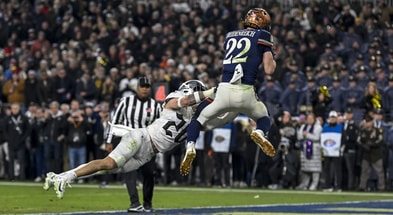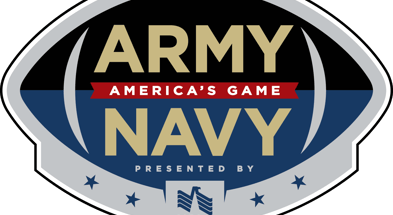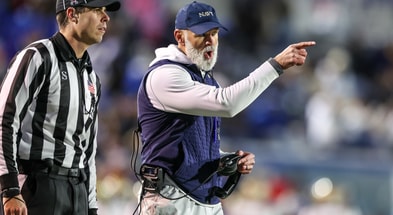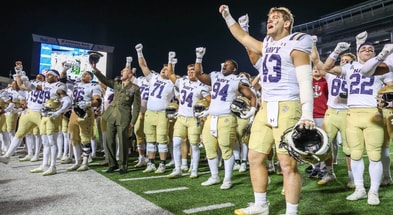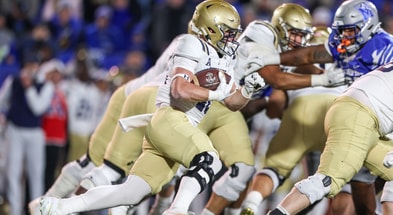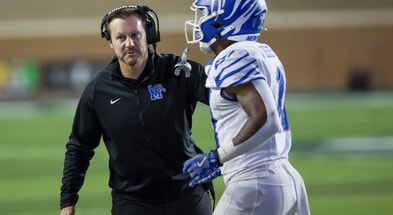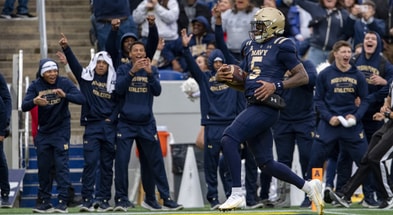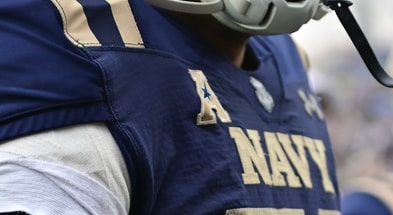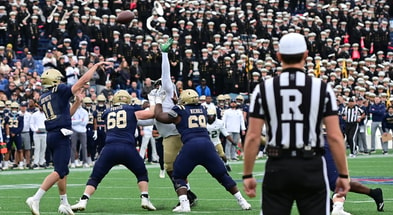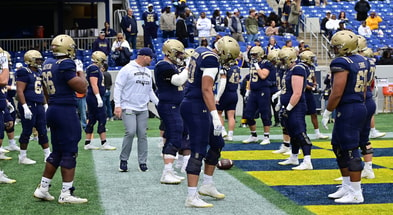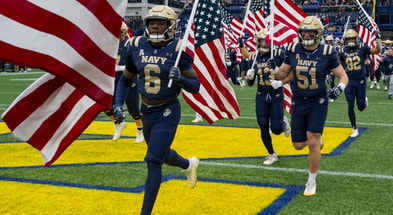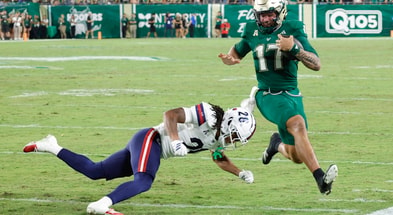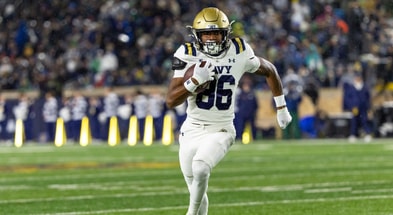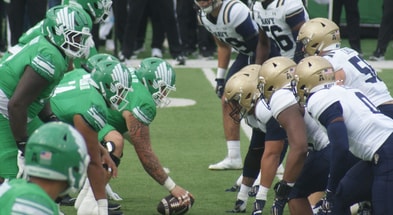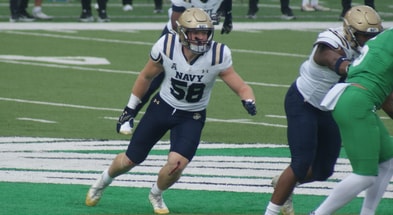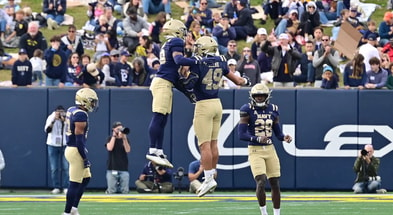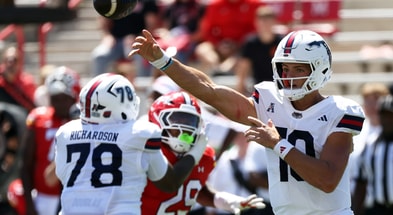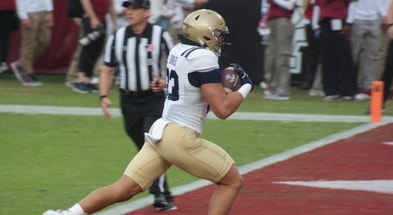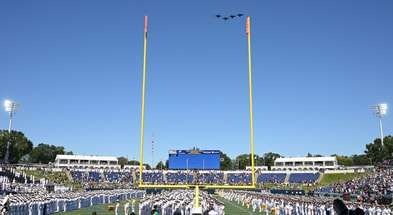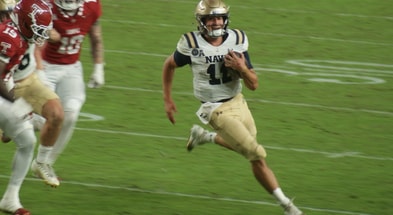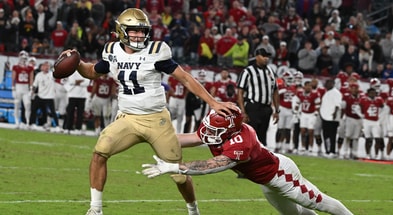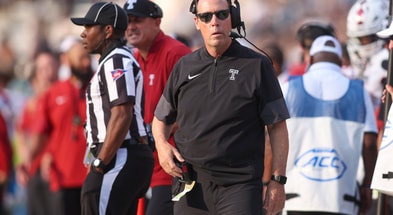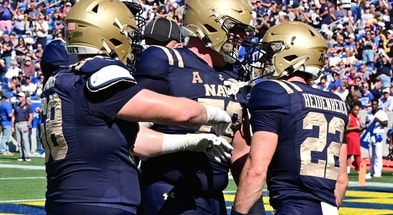The North Texas Preview
After Houston, Cincinnati, and UCF left the American to join the Big 12, fans and media alike seemed confused about the six schools chosen to fill the void. Some of them hadn’t experienced much success in recent years, leading to questions about their value to the league.
But short-term strength of schedule was never the American’s goal. The conference made its choices based on the potential for long-term growth, which is why Texas was such a priority. From 2000-2022, Texas gained more than 9 million residents, the most of any state and a 43% increase for what was already the nation’s second-most populous. The state’s colleges and universities are similarly growing in response, reaching a record of 1.6 million enrolled students this fall. Successful growth requires investment, and that includes athletics. The American saw these schools as motivated to invest in themselves, which would lead to long-term success.
At first, the transfer portal helped with the process. Texas is a recruiting target for almost every major football program in the country, so a significant amount of talent leaves the state. However, if things didn’t work out elsewhere or if graduate transfers wanted to spend their last season closer to home, Texas programs were a popular destination. In many cases, they still are, although not to the same extent.
That’s because NIL has changed the formula. Players transfer to where they’ll be paid. Traditional investment in athletics is no longer the path to winning on the field. Today, football success largely depends on the amount of money programs can allocate for roster-building. Being located in a thriving, football-obsessed state is good for recruiting, but recruiting means nothing if you can’t afford to retain those players when they become sophomores and juniors. It has made life challenging not only for the newcomers to the American, but also for many of the legacy schools as well.
But despite the headwinds, North Texas keeps picking up steam. They finished 5-7 in their first year in the American, made a bowl game in year two, and now, in year three, they are 7-1 and conference championship contenders. Consistency– never mind growth– is hard to come by in an era when teams remake their rosters every year. It’s a testament to how good of a job UNT head coach Eric Morris has done.
Last week, we talked about the coaching lineage of FAU‘s Zach Kittley. Morris is cut from the same Air Raid cloth. He was a wide receiver at Texas Tech under the late Mike Leach from 2004-2008. He had three different position coaches during that time: Lincoln Riley, Dana Holgorsen, and Sonny Dykes. In 2012, he was the receivers coach for Leach at Washington State. The next season, he was brought back to Lubbock to be Kliff Kingsbury‘s offensive coordinator, where his quarterback was current insurance pitchman Patrick Mahomes.
As is the trend with Air Raid coaches, Morris got his first head coaching job at the ripe old age of 32, taking over at Incarnate Word. The team Morris inherited had just finished 1-10. In his first season, he led the Cardinals to a 6-5 record, a share of the Southland conference title, and their first-ever berth in the FCS playoffs. UIW’s offense improved from a meager 293.2 yards per game to 483.2 yards per game. In 2021, UIW went 10-3, won the Southland outright, and advanced to the second round of the playoffs. He returned to Washington State for a year to serve as the Cougars’ offensive coordinator before North Texas hired him as their head coach.
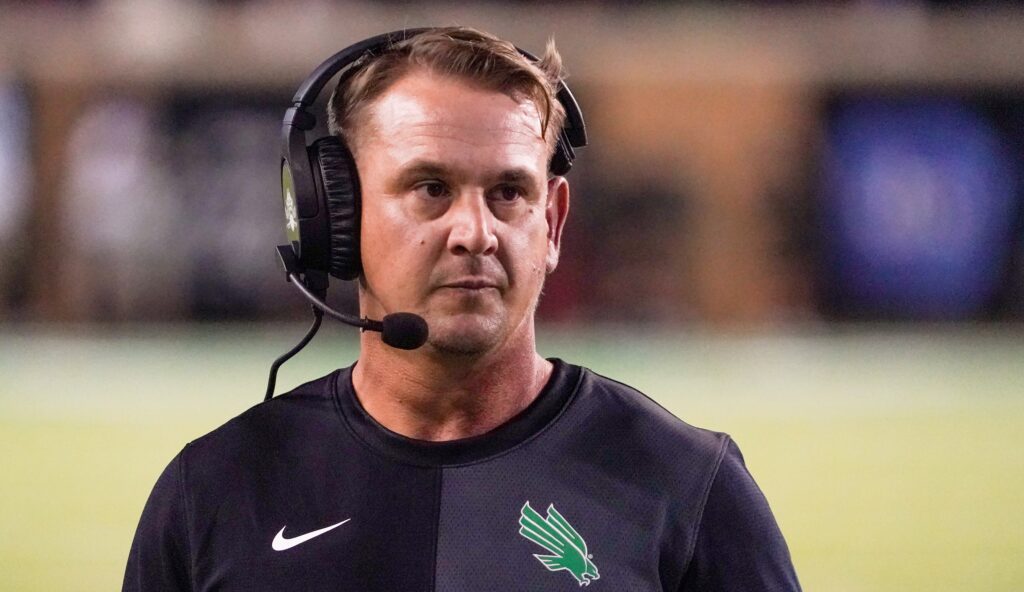
Perhaps it shouldn’t be a surprise to see that pattern play out in Denton, since the same offense is also the driving force behind the Mean Green’s success. This season, North Texas boasts the top scoring offense in the nation, averaging a whopping 46.1 points per game. They’re fifth in total offense, with 495.8 yards per game. After suffering their only setback of the season against USF, they’ve won two in a row by a combined score of 109-37. They’ll also come into Saturday’s game extremely motivated. Navy and a little tiebreaking luck are the biggest obstacles left in their path to the conference championship game, with games at UAB and Rice plus a home finale against Temple left to play. Saturday’s game is pivotal to the Mean Green’s season, and Navy can expect an effort that reflects the magnitude of the occasion.
So what is it about the North Texas offense that makes it so effective? Last week, we talked about how the Air Raid is less of a strictly defined offense and more of a philosophy. The goal is to set up routes so quarterbacks can read zone defenders and deliver the ball based on gaining leverage and creating space. Against man coverage, the offense looks for rubs, mesh routes, and bunch/stack formations to create separation. If the defense tries to bring extra pass rushers, the offense will throw a tunnel screen or call a hot route. Or they’ll fake the screen and throw deep for big yardage. This is all an oversimplification, but it gives you an idea of the general mindset.
But with North Texas, it isn’t just about throwing the ball. While FAU ran to keep defenses honest, UNT runs because they’re good at it, averaging over 5 yards per carry and 178 yards per game. Freshman running back Caleb Hawkins is 23rd in the country with 6.2 yards per carry. He also has seven touchdowns. As a team, North Texas is second in the country in rushing touchdowns with 26. North Texas!
Most Air Raid teams treat the run game as a novelty, but against UNT, defenses have to make it a priority. That creates room for the passing game to pick up bigger chunks of yardage. Redshirt freshman quarterback Drew Mestemaker— one of the great stories in college football this year– is the nation’s fourth-leading passer at 308.5 yards per game. But he isn’t just dinking and dunking his way down the field; his 8.6 yards per attempt are 22nd in the country.
Receivers Wyatt Young and Cameron Dorner have combined for 67 catches, 1,052 yards, and 11 touchdowns. Miles Coleman had been the team’s leading receiver, but he missed the last two games with an injury. His status is unclear for this week; in his press conference, Morris only commented that he is “working back into some stuff.” Either way, it’s clear that Navy can’t be focused on any one receiver. The Mean Green have the consistency on the ground to keep the chains moving, and the explosiveness through the air to make the chains irrelevant.
It all feels like a perfect storm of offense facing the Mids this week, which is concerning for a defense that has looked bad at times, particularly against the pass. But Navy looked much better against FAU last week. Could that plan help again on Saturday? Well, maybe a little. Certainly, the Mids will prioritize masking their coverages before the snap again this week. But UNT’s willingness and ability to run the ball may force Navy to add an extra defender to the box, something they didn’t need to do to stop FAU. It also makes North Texas far more effective in the red zone. Navy was content to allow checkdowns and scrambling by FAU because they knew that once the Owls reached the 20-yard line, there was a good chance they’d settle for a field goal. North Texas will not; they score touchdowns on 75% of their red zone trips. Stopping them– as much as possible, anyway– requires a more hands-on approach.
Interestingly enough, the Mids did a reasonably good job of it in 2023, the last time these teams met. North Texas is better now, but there were no slouches back then; they averaged the same total yardage per game (495.8). North Texas quarterback Chandler Rogers completed 69% of his passes while throwing for 267 yards and a touchdown. The Mean Green also had 206 rushing yards, including touchdown runs of 75 and 47 yards. But while the Mids gave up a lot of yards, they also made plays that got themselves off the field. Navy’s defense had a school-record eight sacks, held UNT to 2-11 on third down, forced two turnovers, and made a goal-line stand to set the tone early on. That’s the key for Navy this week; you don’t need to replicate the Steel Curtain. You just have to create opportunities to get off the field.
Not that doing so is any easier a task. UNT’s offensive line has played well so far, allowing only 4.1 tackles for loss per game. They’ve only given up 1.38 sacks per game, which is a fantastic number considering how often they throw the ball. Mestemaker also takes care of the football, with a stellar 21:4 touchdown-to-interception ratio. This is a problem that no defensive coordinator wants to face.
In the 2023 game, Navy did a few things that helped keep the UNT offense in check. The defensive line was able to do a lot on its own to stop the run. Here, you can see both Donald Berniard and Clay Cromwell getting double-teamed, with both holding their ground. The OL’s inability to get movement from them made the running lane hard to squeeze through and freed up the linebackers.
Despite the stats, Navy’s run defense was actually pretty stout. North Texas ran the ball 36 times for 206 yards. That entire total came on seven carries. The rest consisted of 21 carries for 51 yards, which was offset by 53 yards lost on sacks. However, while the Mids gave up big plays, it was worth it to disrupt the run game’s consistency and force more third-and-long situations.
The Mids also used three safeties, with Rayuan Lane often lining up at the second level, almost like a deep middle linebacker. This allowed the Mids to utilize his range, as he made plays from sideline to sideline as well as rushing the quarterback.
I’m not sure that “just use your NFL-caliber safety” is a reasonable game plan, but it at least shows P.J. Volker‘s willingness to get creative, and I expect to see something out of the ordinary again this weekend.
But the biggest story of the game for the Navy defense was their ability to pressure the quarterback. The Mids had a school-record eight sacks, with five coming in the second half. UNT had a difficult time with Navy’s simulated pressure, especially when they needed points in the fourth quarter. Two Navy sacks ultimately clinched the game for the Mids.
The first of those sacks belonged to Luke Pirris, who forced a fumble that the Mids recovered and turned into points. On this play, UNT is lined up in an empty backfield. The Mids show pressure, so the quarterback has to account for six rushers despite having only five blockers. His target is the receiver at the top of the screen, running a short hook pattern. He changes his pass protection to slide in the direction of the throw. His job is to get rid of the ball before the backside pressure gets to him. He does not.
On UNT’s last drive, the Mids ran a cornerback blitz. Most Air Raid quarterbacks are good at reading this and throwing into the blitz, but not here.
Volker hadn’t called that the whole game, so North Texas didn’t recognize it. It was a gutsy call in that situation. I wouldn’t be surprised to see Navy save a call or two like this for a late-game situation.
Defensively, North Texas is a mixed bag. In terms of total defense, they’re actually a little better than Navy, giving up 361 yards per game. They lead the conference in pass defense. They also do a good job of getting after the quarterback, with 2.3 sacks per game. But there are other areas where they really struggle. The Mean Green are ranked 100 or worse in rushing defense, red zone defense, and third-down defense. All of these factors appear to be very favorable for the Mids.
But for North Texas, none of that really matters. For them, the one number that stands out is turnovers. UNT has forced a whopping 17 of them, which is third in the country. The goal of the Mean Green defense is to generate extra possessions for the offense, and that’s exactly what they do. They’re so confident in their offense that they feel they’ll win every game as long as they get the ball to them enough times.
Generating turnovers is a calling card for defensive coordinator Skyler Cassity, who had the same job last year at Sam Houston State. His Bearkats were seventh nationally in takeaways, and he brought six of his players with him to Denton. All of them are contributors. The heart of his defense is at linebacker, where seniors Trey Fields and Shane Whittier, along with junior Ethan Wesloski, anchor the unit. All three have more than 50 tackles this season, led by Whittier, who averages 7.13 per game.
Interestingly, the Mean Green faced Army earlier this season, although I’m not sure how valuable that film is to the Mids this week. UNT gave up 488 total yards, including 387 on the ground. True to their nature, they also forced three turnovers, enabling the offense to jump to a 21-0 lead from the outset. But it still took a stop from inside the 10-yard line at the end of regulation to force overtime, where they eventually secured the victory.
UNT uses a base 4-3 defense, but they never lined up that way against Army. Instead, they rotated between three different looks.
First, they used an odd front. When they lined up in a 3-4, they always had an extra defender also attacking the line of scrimmage. Sometimes it was an inside linebacker trying to shoot through a gap:
And sometimes it was a safety on the edge:
They also lined up in a 4-4 with a single deep safety:
And finally, they used a 4-2-5 with double 3-techniques. The two 3-techs are designed to prevent the guards from reaching the second level, thereby freeing up the linebackers.
(Notre Dame used a variation of this in the 2010 game.)
While it’s unlikely that UNT will replicate this, I do think we’ll see multiple fronts from the defense. Other defenses have done the same, but Blake Horvath was consistently able to get the Mids in the right play.
One thing that was evident watching the game was that North Texas did not respect Army’s passing game at all. It almost burned them at the end, too, when a 68-yard touchdown pass made it 38-35 with 2:56 to play. Navy is much more of a downfield passing threat, so I don’t think Cassity will be quite as aggressive as he was here. If he is, though, the Mids will have to connect on the opportunities that open up as a result.
Overall, this is shaping up to be a whale of a football game. The two teams are very evenly matched, and they both have strengths that will attack each other’s weaknesses. It’s nothing but heavyweight fights from here on out for the Mids. On Saturday, we’ll see if they come out swinging.
